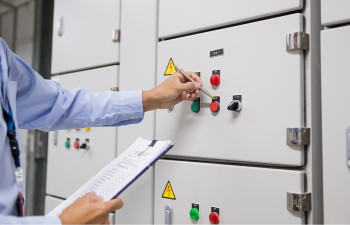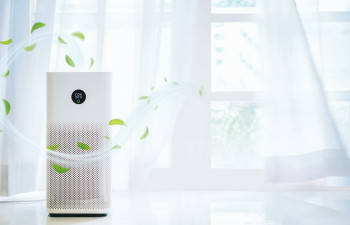Do air purifiers help with COVID?
COVID is spread by tiny virus-carrying droplets in the air that land on people and surfaces. When these droplets are breathed in, or people touch an infected surface and then touch their face, the respiratory system can be infected.
In homes and enclosed spaces, ventilation plays a crucial role in helping coronavirus droplets to disperse.
Many people wear masks outside the home, which help contain the COVID-infected droplets emitted through simple actions such as sneezing, talking, coughing, singing, and even breathing.
However, when we’re indoors, it’s a different matter. There is always the possibility that a member of your household has come into contact with virus droplets and brought them home. They will have no way of knowing that this has happened. The droplets can then circulate indoors, to be breathed in by other people. Good ventilation helps disperse droplets, but this can be difficult during the colder winter months.
A new COVID-19 study showed that coronavirus droplets are staying airborne for as long as three hours before they settle on floors or surfaces. This is longer than originally thought. Now people are looking for new ways to ensure their indoor air does not contain COVID-laden droplets.
The good news is that there has been ongoing research into the effectiveness of air purifiers and air cleaners in protecting people from COVID.
Air purifiers and viruses in the air
Air purifiers are now being used to remove coronavirus-laden droplets from the air in homes, enclosed spaces, and other indoor areas by removing airborne virus droplets and reducing the spread of COVID.
An air purifier works to reduce COVID by drawing in air and pushing it through a filtration system that traps the droplets. The cleaned air can then circulate back into the room.
Portable air purifiers capture viruses by feeding air through HEPA filters that are effective at trapping airborne particles, including Covid-carrying droplets.
True HEPA (high-efficiency particulate air) filter is an important element of an air purifier as it was developed to trap large and small particles from the air, and significantly improve air quality.
True HEPA filters are designed and rated to trap airborne particles that are as small as 0.3 microns at an efficiency rate of at least 99.95%.
Air purifier filters are made from fibreglass mesh of a fine grade to trap tiny particles, before pushing out clean air. You must replace the filters regularly as they will clog up with particles of different sizes over time, and gradually become ineffective.
The larger particles are trapped almost as soon as they hit the filter. Smaller particulates go through the larger holes, but the ultra-small holes will stop them.
Some air purifiers incorporate filters that you can gently wash and reuse, whilst others have an activated carbon filter that absorbs the airborne viruses.
The size of the air purifier and the room size largely determine which air purifier you choose. The living room is generally one of the largest rooms and would benefit from a powerful air purifier to reduce the spread of COVID. Smaller rooms can exhibit higher levels of virus droplets as there is less room for the droplets to disperse. So even small rooms will benefit from an air purifier that has a high-efficiency rating.
The best way to determine which type of air purifier you need for allergies is to calculate the CADR (clean air delivery rate), a measurement developed by the Association of Home Appliance Manufacturers (AHAM). This calculates the amount of air a filtration system can process and clean in an hour. A higher CADR rate means air is cleaned more quickly and effectively.
Always keep the vents on the air purifier clear of any blockages, and avoid putting portable air purifiers in corners or against walls. Make sure there is plenty of space around them so they can work at an efficient level.
Air purifiers don’t usually work as well in bathrooms or kitchens because these rooms often have a more humid atmosphere, making the air purifier less efficient.
It's also been found that COVID virus droplets don’t appear to circulate for the same length of time in hot, humid environments.
In many commercial buildings, air purifiers are incorporated into built-in air conditioning systems. But with a range of portable air purifiers available, there are models small enough to sit on a table.
While air purifiers for COVID won’t remove 100% of the airborne virus, they will go a long way to removing most of the infectious droplets.
How do we reduce the risk of spreading COVID and other viruses in the air?
The latest studies have demonstrated that air purifiers, which have been tested for the removal of virus-carrying droplets, have had a positive impact on reducing the spread of COVID and improving air quality.
For example, in November 2021, the University of Cambridge reported on their joint study with Addenbrooke’s Hospital in the UK, which found that air purifiers fitted with HEPA filters and UV light sterilisers were able to remove most airborne traces of COVID in the hospital wards. The added benefit is that the purifiers also filtered out other viral, fungal, and bacterial bioaerosols – airborne particles that incorporate living organisms – successfully.
The Centre for Disease Control (CDC) in the USA also published a report in July 2021 documenting their research into using portable HEPA air cleaners to reduce the risk of spreading COVID in office environments, such as conference rooms. A significant reduction in exposure to coronavirus was reported when HEPA air purifiers were used.
In August 2022, studies took place that looked at the effectiveness of using air purifiers or air cleaners in schools to protect the younger generation. One study is examining how air cleaners could reduce the spread of COVID by comparing HEPA-filtered air purifiers recycling air through an enclosed unit and using UV light to inactivate viruses and other micro-organisms.
It must be pointed out that no UV light was emitted from the enclosed unit. Ten of the schools in this study are acting as the control group while the other 20 schools are split into two groups; the results are due in Autumn 2022.
Certain environments enable COVID-bearing droplets to circulate more quickly. The atmosphere in crowded places, such as bars, restaurants, and parties is more likely to have airborne droplets that not only hang in the air for longer but can also spread over distances of up to a metre, which is considered the conversational distance.
A distance of 2 metres between people is considered better for safety. Any indoor area that is not well-ventilated can enhance the spread of COVID-laden droplets. Activities such as playing sport or singing can also facilitate transmission.
The WHO (World Health Organisation) recommends that people follow the "Three Cs" when thinking about the settings in which COVID spreads quickly and easily:
- Crowded places
- Close-contact settings, such as meetings, conference rooms, restaurants, bars or any situation where people are talking to each other in close proximity
- Confined and enclosed places that have poor ventilation
As well as bearing in mind the Three Cs, there is plenty of other guidance that should be followed to reduce the risk of spreading the coronavirus, such as wearing a mask, good ventilation, using an air purifier or air cleaner, covering your mouth with tissues when coughing or sneezing, and, of course, being vaccinated against COVID.
Real world data has indicated that HEPA air cleaners are able to effectively remove most airborne COVID in enclosed spaces, reducing the risk of infection. However, it must be remembered that air purifiers can't compensate completely for poor ventilation.
It appears COVID is not going away anytime soon, particularly with new variants such as Delta and Omicron. The need to find proven ways to remove virus-carrying droplets, as well as other air pollutants, when indoors is vital. Improving air quality and ventilation during winter is driving the use of air purifiers in the battle against COVID.
Studies have demonstrated that air purifiers fitted with HEPA filtration systems and UV sterilisers can help to reduce the spread of COVID. They have also demonstrated efficacy in removing other viruses and contaminants from the air, reducing the risk of developing other health complications and with benefits for allergy sufferers.
While air purifiers don't completely replace good ventilation in a room, they make a significant impact on improving air quality.





